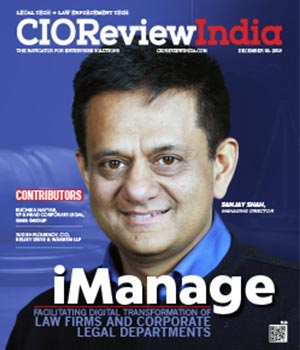
Legal's Speed of Process is Impacted by Significant Technologies
Swami Nathan, SVP - Legal, Compliance & Company Secretary, Tata AIA Life Insurance | Tuesday, 10 October 2017, 10:13 IST
 The legal services entails enormous reading and referencing to various Acts, Regulations, commentaries, case laws etc. With effective use of technology, all the related data can be well organised and made available for referencing which in turn will play a significant role in forming an opinion for a case in hand. Technology also helps in assimilating the background of a prospective Client. Technology can further ensure consistency of opinion across all Clients for similar queries. Consistency of data and stabilised technology-based processes help in enhancing the efficiency of legal services. Access to database of legal experts across the Globe has enabled reach out to practices across the world and across international borders. Technology has positively impacted almost every aspect of legal practice including Litigations, Advisory, Counselling, Arbitration, negotiation etc. In fact technology is now embedded in the legal practices to an extent where Court summons are now sent over Whatsapp and are treated as legally valid. All judgements, case laws, cause lists etc. are now available online for almost every level of Judiciary in the country. The timelines for legal redressal has now been crunched significantly due to speed of processes with the aid of technology.
The legal services entails enormous reading and referencing to various Acts, Regulations, commentaries, case laws etc. With effective use of technology, all the related data can be well organised and made available for referencing which in turn will play a significant role in forming an opinion for a case in hand. Technology also helps in assimilating the background of a prospective Client. Technology can further ensure consistency of opinion across all Clients for similar queries. Consistency of data and stabilised technology-based processes help in enhancing the efficiency of legal services. Access to database of legal experts across the Globe has enabled reach out to practices across the world and across international borders. Technology has positively impacted almost every aspect of legal practice including Litigations, Advisory, Counselling, Arbitration, negotiation etc. In fact technology is now embedded in the legal practices to an extent where Court summons are now sent over Whatsapp and are treated as legally valid. All judgements, case laws, cause lists etc. are now available online for almost every level of Judiciary in the country. The timelines for legal redressal has now been crunched significantly due to speed of processes with the aid of technology.
Legal Trends Impacting Industry
With the tightening of Anti Money Laundering laws, the systems, policies and processes in Life Insurance companies have only got more complicated and stricter, thus leading to strain in automation and thus manual interventions. The Insurance Act was amended in 2015 and quite a few matters were moved from the Act into Regulations. The Insurance Regulatory and Development Authority of India (IRDAI) issued a spate of regulations in the last 2 years which have again resulted in Insurers going thru a roller coaster ride. Section 45 of the Act has been amended thus giving a time of a maximum of 3 years to the Insurance Company to contest a fraudulent Life Insurance policy. This means after a Policy has been active for 3 years, no claim can be rejected for any medical non-disclosure or for any other reason. This has resulted in Insurers re-working on their risk appetite which could also result in product pricing. Thanks to social media, every citizen in the country today is well informed about legalities of an insurance contract and thus it is no longer enough to be cryptic in communication and customers now demand lucid explanation on their queries and these are prone to legal risks. Courts, Consumer Forums and Insurance Ombudsmen have also passed important judgements that have impacted the Industry.
Insurance companies have greatly leveraged technology to make significant progress on their customer reach resulting in efficient sales and servicing. Life Insurance today is largely sold through Mobiles and Tablets apart from online purchases through websites. Online customer portals today enable self servicing for both financial and non-financial transactions. With all these and with the spate of cyber attacks like the latest Ransomware etc., it has become extremely critical for an Insurance company to secure all areas of technology that are exposed to the cyberspace and internet in any manner. This is feasible only by implementing a strong and robust cyber security mechanism which consists of both hardware and software. These mechanisms also have to be constantly upgraded to meet the rapidly changing technological environment.
Future of Insurance and Insurance Regulation
Non-life Insurance will continue to be driven by business growth and complexities. It will also grow beyond the geographical boundaries of the country. The regulations have perhaps reached a stage where no further changes are required and the industry should be left to mature on its own. Life Insurance will also grow at a noticeable pace and mergers are inevitable given the stressful cost structures. Bank promoted insurance companies will feel the strain since the promoter banks are already bogged with increasing NPAs and the Reserve Bank has strongly advised Banks to focus on their core business. Customers continue to be attracted by Unit Linked products while Insurers would like to focus on more profitable traditional and protection products. Regulations have to enable more innovation in products, sales practices and customer services.
Health Insurance is a new sector and is growing at a rapid pace. With increasing health related issues, customers are now becoming more aware of the need for health insurance and healthcare. Along with curative measures, regulations should facilitate preventive healthcare and wellness programs. Markets continue to be plagued by instances of spurious calls, mis-selling, fraudulent sales as well as fraudulent claims. While regulations are strict on these matters, the Insurers and intermediaries have to work jointly towards a strong self-regulatory mechanism to reduce and prevent such instances in future.
CIO Viewpoint
RPA: A Shift From Monotony To Thinking
By Aniruddha Mehta, AGM QA IT, Alembic Pharmaceuticals Limited
Open Banking Solutions to drive business value...
By Vishal Sinha, President and CIO, Tranzlease Holdings (I) Pvt. Ltd
Upgrading Financial Services with Aneffective SDLC
By Nafees Ahmed, CIO, Indiabulls
CXO Insights
Future Of Legal - A Transformation Journey
By Archana Sasan, VP - Legal Counsel, Dell
By Dipendar Singh, Head - Information Technology, H&M
Smart Innovation Trends Transforming The Future...




.jpg)



